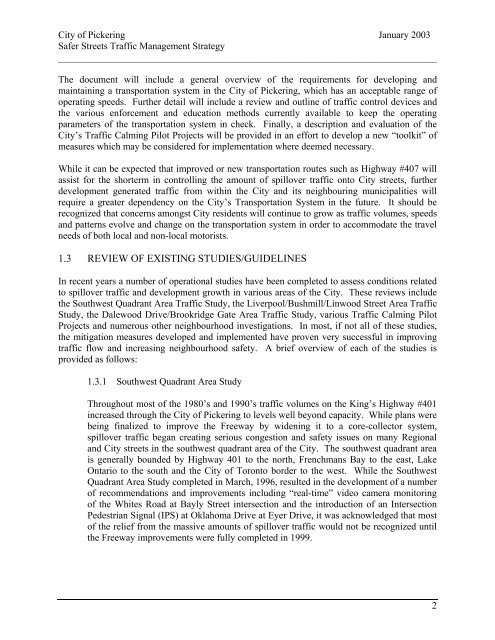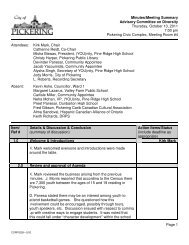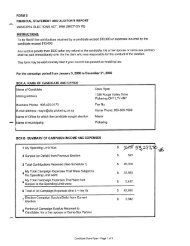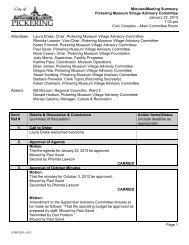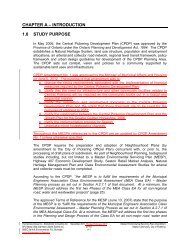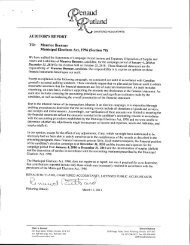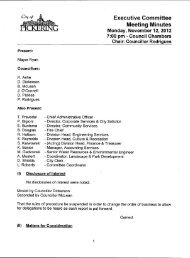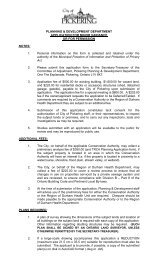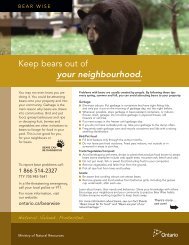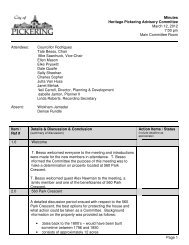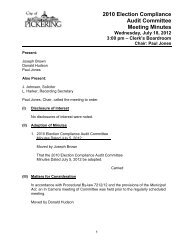foreword - City of Pickering
foreword - City of Pickering
foreword - City of Pickering
Create successful ePaper yourself
Turn your PDF publications into a flip-book with our unique Google optimized e-Paper software.
<strong>City</strong> <strong>of</strong> <strong>Pickering</strong> January 2003<br />
Safer Streets Traffic Management Strategy<br />
______________________________________________________________________________<br />
The document will include a general overview <strong>of</strong> the requirements for developing and<br />
maintaining a transportation system in the <strong>City</strong> <strong>of</strong> <strong>Pickering</strong>, which has an acceptable range <strong>of</strong><br />
operating speeds. Further detail will include a review and outline <strong>of</strong> traffic control devices and<br />
the various enforcement and education methods currently available to keep the operating<br />
parameters <strong>of</strong> the transportation system in check. Finally, a description and evaluation <strong>of</strong> the<br />
<strong>City</strong>’s Traffic Calming Pilot Projects will be provided in an effort to develop a new “toolkit” <strong>of</strong><br />
measures which may be considered for implementation where deemed necessary.<br />
While it can be expected that improved or new transportation routes such as Highway #407 will<br />
assist for the shorterm in controlling the amount <strong>of</strong> spillover traffic onto <strong>City</strong> streets, further<br />
development generated traffic from within the <strong>City</strong> and its neighbouring municipalities will<br />
require a greater dependency on the <strong>City</strong>’s Transportation System in the future. It should be<br />
recognized that concerns amongst <strong>City</strong> residents will continue to grow as traffic volumes, speeds<br />
and patterns evolve and change on the transportation system in order to accommodate the travel<br />
needs <strong>of</strong> both local and non-local motorists.<br />
1.3 REVIEW OF EXISTING STUDIES/GUIDELINES<br />
In recent years a number <strong>of</strong> operational studies have been completed to assess conditions related<br />
to spillover traffic and development growth in various areas <strong>of</strong> the <strong>City</strong>. These reviews include<br />
the Southwest Quadrant Area Traffic Study, the Liverpool/Bushmill/Linwood Street Area Traffic<br />
Study, the Dalewood Drive/Brookridge Gate Area Traffic Study, various Traffic Calming Pilot<br />
Projects and numerous other neighbourhood investigations. In most, if not all <strong>of</strong> these studies,<br />
the mitigation measures developed and implemented have proven very successful in improving<br />
traffic flow and increasing neighbourhood safety. A brief overview <strong>of</strong> each <strong>of</strong> the studies is<br />
provided as follows:<br />
1.3.1 Southwest Quadrant Area Study<br />
Throughout most <strong>of</strong> the 1980’s and 1990’s traffic volumes on the King’s Highway #401<br />
increased through the <strong>City</strong> <strong>of</strong> <strong>Pickering</strong> to levels well beyond capacity. While plans were<br />
being finalized to improve the Freeway by widening it to a core-collector system,<br />
spillover traffic began creating serious congestion and safety issues on many Regional<br />
and <strong>City</strong> streets in the southwest quadrant area <strong>of</strong> the <strong>City</strong>. The southwest quadrant area<br />
is generally bounded by Highway 401 to the north, Frenchmans Bay to the east, Lake<br />
Ontario to the south and the <strong>City</strong> <strong>of</strong> Toronto border to the west. While the Southwest<br />
Quadrant Area Study completed in March, 1996, resulted in the development <strong>of</strong> a number<br />
<strong>of</strong> recommendations and improvements including “real-time” video camera monitoring<br />
<strong>of</strong> the Whites Road at Bayly Street intersection and the introduction <strong>of</strong> an Intersection<br />
Pedestrian Signal (IPS) at Oklahoma Drive at Eyer Drive, it was acknowledged that most<br />
<strong>of</strong> the relief from the massive amounts <strong>of</strong> spillover traffic would not be recognized until<br />
the Freeway improvements were fully completed in 1999.<br />
2


